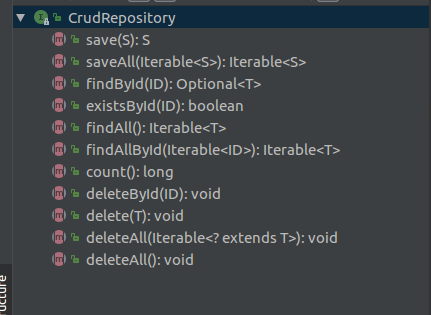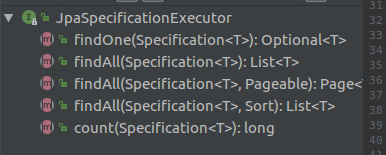Spring Data - Spring Data JPA 提供的各种Repository接口
Spring Data Jpa
最近博主越来越懒了,深知这样不行。还是决定努力奋斗,如此一来,就有了一下一波复习
演示代码都基于Spring Boot + Spring Data JPA
传送门: 博主的测试代码
------------------------------------------------------------------------------------------------------------------------------
什么是Spring Data JPA?
Spring Data 是Spring提供的操作数据的框架在Spring data JPA是Spring data的一个模块,通过Spring data 基于jpa标准操作数据的模块。
Spring Data的核心能力,就是基于JPA操作数据,并且可以简化操作持久层的代码。
Spring Data JPA提供的核心接口
前提数据:
-- MySQL dump 10.13 Distrib 5.6.16, for debian-linux-gnu (x86_64)
--
-- Host: localhost Database: amber
-- ------------------------------------------------------
-- Server version 5.6.16-1~exp1 /*!40101 SET @OLD_CHARACTER_SET_CLIENT=@@CHARACTER_SET_CLIENT */;
/*!40101 SET @OLD_CHARACTER_SET_RESULTS=@@CHARACTER_SET_RESULTS */;
/*!40101 SET @OLD_COLLATION_CONNECTION=@@COLLATION_CONNECTION */;
/*!40101 SET NAMES utf8 */;
/*!40103 SET @OLD_TIME_ZONE=@@TIME_ZONE */;
/*!40103 SET TIME_ZONE='+00:00' */;
/*!40014 SET @OLD_UNIQUE_CHECKS=@@UNIQUE_CHECKS, UNIQUE_CHECKS=0 */;
/*!40014 SET @OLD_FOREIGN_KEY_CHECKS=@@FOREIGN_KEY_CHECKS, FOREIGN_KEY_CHECKS=0 */;
/*!40101 SET @OLD_SQL_MODE=@@SQL_MODE, SQL_MODE='NO_AUTO_VALUE_ON_ZERO' */;
/*!40111 SET @OLD_SQL_NOTES=@@SQL_NOTES, SQL_NOTES=0 */; --
-- Table structure for table `table_user`
-- DROP TABLE IF EXISTS `table_user`;
/*!40101 SET @saved_cs_client = @@character_set_client */;
/*!40101 SET character_set_client = utf8 */;
CREATE TABLE `table_user` (
`id` int(11) NOT NULL DEFAULT '',
`name` varchar(255) DEFAULT NULL,
`password` varchar(255) DEFAULT NULL,
`address` varchar(255) DEFAULT NULL,
`age` int(11) DEFAULT NULL,
PRIMARY KEY (`id`)
) ENGINE=MyISAM DEFAULT CHARSET=latin1;
/*!40101 SET character_set_client = @saved_cs_client */; --
-- Dumping data for table `table_user`
-- LOCK TABLES `table_user` WRITE;
/*!40000 ALTER TABLE `table_user` DISABLE KEYS */;
INSERT INTO `table_user` VALUES (4,'tony',NULL,'shanghai',18),(5,'amber',NULL,'shanghai',18),(2,'amber1',NULL,'shanghai',18),(3,'tony',NULL,'shanghai',18),(0,'amber1',NULL,'shanghai',18),(6,'amber',NULL,'shanghai',18);
/*!40000 ALTER TABLE `table_user` ENABLE KEYS */;
UNLOCK TABLES;
/*!40103 SET TIME_ZONE=@OLD_TIME_ZONE */; /*!40101 SET SQL_MODE=@OLD_SQL_MODE */;
/*!40014 SET FOREIGN_KEY_CHECKS=@OLD_FOREIGN_KEY_CHECKS */;
/*!40014 SET UNIQUE_CHECKS=@OLD_UNIQUE_CHECKS */;
/*!40101 SET CHARACTER_SET_CLIENT=@OLD_CHARACTER_SET_CLIENT */;
/*!40101 SET CHARACTER_SET_RESULTS=@OLD_CHARACTER_SET_RESULTS */;
/*!40101 SET COLLATION_CONNECTION=@OLD_COLLATION_CONNECTION */;
/*!40111 SET SQL_NOTES=@OLD_SQL_NOTES */; -- Dump completed on 2019-01-13 13:43:57
SQL
package com.amber.pojo; import lombok.Data;
import javax.persistence.*; @Entity
@Table(name = "table_user")
@Data
public class User { @Id
@GeneratedValue
private Integer id;
private String name;
private Integer age;
private String address; }
User
<?xml version="1.0" encoding="UTF-8"?>
<project xmlns="http://maven.apache.org/POM/4.0.0"
xmlns:xsi="http://www.w3.org/2001/XMLSchema-instance"
xsi:schemaLocation="http://maven.apache.org/POM/4.0.0 http://maven.apache.org/xsd/maven-4.0.0.xsd">
<modelVersion>4.0.0</modelVersion> <groupId>groupId</groupId>
<artifactId>SpringBoot-JPA</artifactId>
<version>1.0-SNAPSHOT</version> <properties>
<java.version>1.8</java.version>
<lombok.version>1.16.20</lombok.version>
</properties>
<parent>
<groupId>org.springframework.boot</groupId>
<artifactId>spring-boot-starter-parent</artifactId>
<version>2.0.5.RELEASE</version>
<relativePath/>
</parent> <dependencies>
<dependency>
<groupId>org.springframework.boot</groupId>
<artifactId>spring-boot-starter-web</artifactId>
</dependency>
<dependency>
<groupId>org.springframework.boot</groupId>
<artifactId>spring-boot-starter-data-jpa</artifactId>
</dependency> <dependency>
<groupId>org.springframework.boot</groupId>
<artifactId>spring-boot-starter-test</artifactId>
</dependency> <!-- https://mvnrepository.com/artifact/mysql/mysql-connector-java -->
<dependency>
<groupId>mysql</groupId>
<artifactId>mysql-connector-java</artifactId>
<version>6.0.5</version>
</dependency> <dependency>
<groupId>org.springframework.boot</groupId>
<artifactId>spring-boot-devtools</artifactId>
<optional>true</optional>
</dependency> <!-- https://mvnrepository.com/artifact/com.alibaba/druid -->
<dependency>
<groupId>com.alibaba</groupId>
<artifactId>druid</artifactId>
<version>1.1.8</version>
</dependency> <!-- https://mvnrepository.com/artifact/org.projectlombok/lombok -->
<dependency>
<groupId>org.projectlombok</groupId>
<artifactId>lombok</artifactId>
<version>${lombok.version}</version>
<scope>provided</scope>
</dependency>
</dependencies>
</project>
pom.xml
Repository:
@org.springframework.stereotype.Repository
public interface UserRepository extends Repository<User, Integer> {
}
- 提供了方法名成查询方式:
方法的名称要遵循 findBy + 属性名(首字母大写) + 查询条件(首字母大写 Is Equals)
findByNameLike(String name)
findByName(String name)
findByNameAndAge(String name, Integer age)
findByNameOrAddress(String name) 等...
- 基于@Query注解的查询和更新
/**
* SQL nativeQuery的值是true 执行的时候不用再转化
* @param name
* @return
*/
@Query(value = "SELECT * FROM table_user WHERE name = ?1", nativeQuery = true)
List<User> findByUsernameSQL(String name);
//基于HQL
/**
* 基于HQL
* @param name
* @param id
* @return
*/
@Query("Update User set name = ?1 WHERE id = ?2")
@Modifying
int updateNameAndId(String name, Integer id);
CrudReposiroty : 继承了Repository
/*
* Copyright 2008-2017 the original author or authors.
*
* Licensed under the Apache License, Version 2.0 (the "License");
* you may not use this file except in compliance with the License.
* You may obtain a copy of the License at
*
* http://www.apache.org/licenses/LICENSE-2.0
*
* Unless required by applicable law or agreed to in writing, software
* distributed under the License is distributed on an "AS IS" BASIS,
* WITHOUT WARRANTIES OR CONDITIONS OF ANY KIND, either express or implied.
* See the License for the specific language governing permissions and
* limitations under the License.
*/
package org.springframework.data.repository; import java.util.Optional; /**
* Interface for generic CRUD operations on a repository for a specific type.
*
* @author Oliver Gierke
* @author Eberhard Wolff
*/
@NoRepositoryBean
public interface CrudRepository<T, ID> extends Repository<T, ID> { /**
* Saves a given entity. Use the returned instance for further operations as the save operation might have changed the
* entity instance completely.
*
* @param entity must not be {@literal null}.
* @return the saved entity will never be {@literal null}.
*/
<S extends T> S save(S entity); /**
* Saves all given entities.
*
* @param entities must not be {@literal null}.
* @return the saved entities will never be {@literal null}.
* @throws IllegalArgumentException in case the given entity is {@literal null}.
*/
<S extends T> Iterable<S> saveAll(Iterable<S> entities); /**
* Retrieves an entity by its id.
*
* @param id must not be {@literal null}.
* @return the entity with the given id or {@literal Optional#empty()} if none found
* @throws IllegalArgumentException if {@code id} is {@literal null}.
*/
Optional<T> findById(ID id); /**
* Returns whether an entity with the given id exists.
*
* @param id must not be {@literal null}.
* @return {@literal true} if an entity with the given id exists, {@literal false} otherwise.
* @throws IllegalArgumentException if {@code id} is {@literal null}.
*/
boolean existsById(ID id); /**
* Returns all instances of the type.
*
* @return all entities
*/
Iterable<T> findAll(); /**
* Returns all instances of the type with the given IDs.
*
* @param ids
* @return
*/
Iterable<T> findAllById(Iterable<ID> ids); /**
* Returns the number of entities available.
*
* @return the number of entities
*/
long count(); /**
* Deletes the entity with the given id.
*
* @param id must not be {@literal null}.
* @throws IllegalArgumentException in case the given {@code id} is {@literal null}
*/
void deleteById(ID id); /**
* Deletes a given entity.
*
* @param entity
* @throws IllegalArgumentException in case the given entity is {@literal null}.
*/
void delete(T entity); /**
* Deletes the given entities.
*
* @param entities
* @throws IllegalArgumentException in case the given {@link Iterable} is {@literal null}.
*/
void deleteAll(Iterable<? extends T> entities); /**
* Deletes all entities managed by the repository.
*/
void deleteAll();
}
CrudRepository

Crud主要是添加了对数据的增删改查的方法
PagingAndSortingRepository: 继承了CrudRepository
/*
* Copyright 2008-2010 the original author or authors.
*
* Licensed under the Apache License, Version 2.0 (the "License");
* you may not use this file except in compliance with the License.
* You may obtain a copy of the License at
*
* http://www.apache.org/licenses/LICENSE-2.0
*
* Unless required by applicable law or agreed to in writing, software
* distributed under the License is distributed on an "AS IS" BASIS,
* WITHOUT WARRANTIES OR CONDITIONS OF ANY KIND, either express or implied.
* See the License for the specific language governing permissions and
* limitations under the License.
*/
package org.springframework.data.repository; import org.springframework.data.domain.Page;
import org.springframework.data.domain.Pageable;
import org.springframework.data.domain.Sort; /**
* Extension of {@link CrudRepository} to provide additional methods to retrieve entities using the pagination and
* sorting abstraction.
*
* @author Oliver Gierke
* @see Sort
* @see Pageable
* @see Page
*/
@NoRepositoryBean
public interface PagingAndSortingRepository<T, ID> extends CrudRepository<T, ID> { /**
* Returns all entities sorted by the given options.
*
* @param sort
* @return all entities sorted by the given options
*/
Iterable<T> findAll(Sort sort); /**
* Returns a {@link Page} of entities meeting the paging restriction provided in the {@code Pageable} object.
*
* @param pageable
* @return a page of entities
*/
Page<T> findAll(Pageable pageable);
}
PagingAndSortingRepository
/**
* 继承了Repository,缺点只能对所有的数据进行排序或者分页
*/
@Repository
public interface UserPagingAndSortingReposiroty extends PagingAndSortingRepository<User, Integer> {
}
package com.amber; import com.amber.pojo.User;
import com.amber.repository.UserPagingAndSortingReposiroty;
import org.junit.Test;
import org.junit.runner.RunWith;
import org.springframework.beans.factory.annotation.Autowired;
import org.springframework.boot.test.context.SpringBootTest;
import org.springframework.data.domain.Page;
import org.springframework.data.domain.PageRequest;
import org.springframework.data.domain.Pageable;
import org.springframework.data.domain.Sort;
import org.springframework.test.context.junit4.SpringJUnit4ClassRunner; import java.util.List; @RunWith(SpringJUnit4ClassRunner.class)
@SpringBootTest(classes = JPAApplication.class)
public class UserPagingAndSortingReposirotyTest { @Autowired
UserPagingAndSortingReposiroty userPagingAndSortingReposiroty; /**
* 排序
*/
@Test
public void TestSort(){
//定义排序规则
Sort.Order order = new Sort.Order(Sort.Direction.DESC, "name");
Sort.Order order1 = new Sort.Order(Sort.Direction.DESC, "id");
//Sort
Sort sort = new Sort(order, order1);
List<User> users = (List<User>)userPagingAndSortingReposiroty.findAll(sort);
System.out.println(users);
} /**
* 分页Pageable封装了分页的参数,当前页,每一页显示的条数,注意当前页是从0开始的
*/
@Test
public void TestPaging(){
//Pageable是个接口
Pageable pageable = new PageRequest(0, 10);
//返回Page对象
Page<User> uses = userPagingAndSortingReposiroty.findAll(pageable);
System.out.println(uses.getTotalElements());
System.out.println(uses.getTotalPages());
System.out.println(uses.getNumberOfElements());
} /**
* 分页 + 排序
*/
@Test
public void TestPagingAndSort(){
//定义排序规则
Sort.Order order = new Sort.Order(Sort.Direction.DESC, "name");
Sort.Order order1 = new Sort.Order(Sort.Direction.DESC, "id");
//Sort
Sort sort = new Sort(order, order1);
//Pageable是个接口
Pageable pageable = new PageRequest(0, 10, sort);
//返回Page对象
Page<User> uses = userPagingAndSortingReposiroty.findAll(pageable);
System.out.println(uses.getTotalElements());
System.out.println(uses.getTotalPages());
System.out.println(uses.getNumberOfElements());
} }
UserPagingAndSortingReposirotyTest
JPARepository: 继承了PagingAndSortingRepository接口
在开发中常用JPARepository
优点: 对继承父接口中方法的返回值进行了适配,因为在父类接口中通常都返回迭代器,需要我们自己进行强制类型转化。而在JpaRepository中,直接返回了List
//
// Source code recreated from a .class file by IntelliJ IDEA
// (powered by Fernflower decompiler)
// package org.springframework.data.jpa.repository; import java.util.List;
import org.springframework.data.domain.Example;
import org.springframework.data.domain.Sort;
import org.springframework.data.repository.NoRepositoryBean;
import org.springframework.data.repository.PagingAndSortingRepository;
import org.springframework.data.repository.query.QueryByExampleExecutor; @NoRepositoryBean
public interface JpaRepository<T, ID> extends PagingAndSortingRepository<T, ID>, QueryByExampleExecutor<T> {
List<T> findAll(); List<T> findAll(Sort var1); List<T> findAllById(Iterable<ID> var1); <S extends T> List<S> saveAll(Iterable<S> var1); void flush(); <S extends T> S saveAndFlush(S var1); void deleteInBatch(Iterable<T> var1); void deleteAllInBatch(); T getOne(ID var1); <S extends T> List<S> findAll(Example<S> var1); <S extends T> List<S> findAll(Example<S> var1, Sort var2);
}
JpaRepository
JpaSpecificationExecutor: 这个接口单独存在,没有继承以上说的接口
主要提供了多条件查询的支持,并且可以在查询中添加分页和排序。
因为这个接口单独存在,因此需要配合以上说的接口使用,如:
/**
* JpaSpecificationExecutor是单独存在的,需要配合这JpaRepository一起使用
*/
@Repository
public interface UserJpaSpecificationExecutor extends JpaSpecificationExecutor<User>, JpaRepository<User, Integer> {
}

package com.amber; import com.amber.pojo.User;
import com.amber.repository.UserJpaSpecificationExecutor;
import org.junit.Test;
import org.junit.runner.RunWith;
import org.springframework.beans.factory.annotation.Autowired;
import org.springframework.boot.test.context.SpringBootTest;
import org.springframework.data.jpa.domain.Specification;
import org.springframework.test.context.junit4.SpringJUnit4ClassRunner; import javax.persistence.criteria.CriteriaBuilder;
import javax.persistence.criteria.CriteriaQuery;
import javax.persistence.criteria.Predicate;
import javax.persistence.criteria.Root;
import java.util.ArrayList;
import java.util.List; @RunWith(SpringJUnit4ClassRunner.class)
@SpringBootTest(classes = JPAApplication.class)
public class UserJpaSecificationExecutorTest { @Autowired
UserJpaSpecificationExecutor userJpaSpecificationExecutor; /**
* 多条件查询的另外一种写法
*/
@Test
public void testUser2(){
//Specification是个接口,封装了查询信息
Specification<User> specification = new Specification<User>() {
/**
* Predicate封装了单个查询条件
* @param root 对查询对象属性的封装,比如我们这里是查询User,因此root可以看成是User
* @param query CriteriaQuery封装了查询中的各部分信息, Select from order
* @param cb CB查询条件的构造器
* @return
*/
@Override
public Predicate toPredicate(Root<User> root, CriteriaQuery<?> query, CriteriaBuilder cb) {
Predicate p1 = cb.equal(root.get("name"), "amber");
Predicate p2 = cb.equal(root.get("age"), "18");
return cb.and(p1,p2);
}
};
List<User> users = userJpaSpecificationExecutor.findAll(specification);
System.out.println(users);
} /**
* 多条件查询
*/
@Test
public void testUser1(){
//Specification是个接口,封装了查询信息
Specification<User> specification = new Specification<User>() {
/**
* Predicate封装了单个查询条件
* @param root 对查询对象属性的封装,比如我们这里是查询User,因此root可以看成是User
* @param query CriteriaQuery封装了查询中的各部分信息, Select from order
* @param cb CB查询条件的构造器
* @return
*/
@Override
public Predicate toPredicate(Root<User> root, CriteriaQuery<?> query, CriteriaBuilder cb) {
List<Predicate> predicates = new ArrayList<>();
Predicate p1 = cb.equal(root.get("name"), "amber");
Predicate p2 = cb.equal(root.get("age"), "18");
predicates.add(p1);
predicates.add(p2);
Predicate[] predicateArr = new Predicate[predicates.size()];
return cb.and(predicates.toArray(predicateArr));
}
};
List<User> users = userJpaSpecificationExecutor.findAll(specification);
System.out.println(users);
} /**
* 单条件查询
*/
@Test
public void testUser(){
//Specification是个接口,封装了查询信息
Specification<User> specification = new Specification<User>() {
/**
* Predicate封装了单个查询条件
* @param root 对查询对象属性的封装,比如我们这里是查询User,因此root可以看成是User
* @param query CriteriaQuery封装了查询中的各部分信息, Select from order
* @param cb CB查询条件的构造器
* @return
*/
@Override
public Predicate toPredicate(Root<User> root, CriteriaQuery<?> query, CriteriaBuilder cb) { Predicate p1 = cb.equal(root.get("name"), "amber");
return p1;
}
};
List<User> users = userJpaSpecificationExecutor.findAll(specification);
System.out.println(users);
}
}
总结:
Spring Data Jpa中一共提供了
- Repository:
- 提供了findBy + 属性方法
- @Query
- HQL: nativeQuery 默认false
- SQL: nativeQuery 默认true
- 更新的时候,需要配合@Modifying使用
- CurdRepository:
- 继承了Repository 主要提供了对数据的增删改查
- 继承了CrudRepository 提供了对数据的分页和排序,缺点是只能对所有的数据进行分页或者排序,不能做条件判断
- 开发中经常使用的接口,主要继承了PagingAndSortRepository,对返回值类型做了适配
- JpaSpecificationExecutor
- 提供多条件查询
PagingAndSortRepository:
JpaRepository: 继承了PagingAndSortRepository
Spring Data - Spring Data JPA 提供的各种Repository接口的更多相关文章
- Spring Data JPA 提供的各种Repository接口作用
各种Repository接口继承关系: Repository : public interface UserRepository extends Repository<User, Integer ...
- 一步步学习 Spring Data 系列之JPA(一)
引入: Spring Data是SpringSource基金会下的一个用于简化数据库访问,并支持云服务的开源框架.其主要目标是使得数据库的访问变得方便快捷,并支持map-reduce框架和云计算数据服 ...
- 一步步学习 Spring Data 系列之JPA(二)
继上一篇文章对Spring Data JPA更深( )一步剖析. 上一篇只是简单的介绍了Spring Data JPA的简单使用,而往往在项目中这一点功能并不能满足我们的需求.这是当然的,在业务中查询 ...
- JPA && Spring Data && Spring Data JPA
1.JPA Java Persistence API,用于对象持久化的一组API,JPA本身是一组规范,让开发者用同一种方式访问不同的ORM框架.其实也就是java实体对象和关系型数据库建立起映射关 ...
- 【Spring】Spring Data JPA
原始JDBC操作数据库 传统JDBC方式实现数据库操作 package com.imooc.util; import java.io.InputStream; import java.sql.*; i ...
- Spring Data JPA 梳理 - JPA与“Spring、Spring Data JPA”的关系
JPA其实也就是java实体对象和关系型数据库建立起映射关系,通过面向对象编程的思想操作关系型数据库的规范. Spring 框架对 JPA 提供的支持主要体现在如下几个方面: 首先,它使得 JPA 配 ...
- java(样品集成框架spring、spring mvc、spring data jpa、hibernate)
这是你自己的参考springside集成框架的开源项目.主要的整合spring.spring mvc.spring data jpa.hibernate几个框架,对于这些框架中仍然感觉更舒适sprin ...
- Spring+SpringMVC+Spring Data JPA完美整合
使用Maven实现SSS框架的整合. 方便记录,专门建了一个pom项目用来整合SSS框架所用的jar包 1.POM项目,作为父级项目,记录整个整合中的依赖jar包pom文件 <project x ...
- spring mvc Spring Data Redis RedisTemplate [转]
http://maven.springframework.org/release/org/springframework/data/spring-data-redis/(spring-data包下载) ...
随机推荐
- 小白专场-FileTransfer-c语言实现
目录 一.集合的简化表示 二.题意理解 三.程序框架搭建 3.1 Input_connection 3.2 Check_connection 3.3 Check_network 四.pta测试 五.按 ...
- python常用数据结构讲解
一:序列 在数学上,序列是被排成一排的对象,而在python中,序列是最基本的数据结构.它的主要特征为拥有索引,每个索引的元素是可迭代对象.都可以进行索引,切片,加,乘,检查成员等操作.在py ...
- SpringBoot整合Nacos注册中心
#### 什么是Nacos Nacos 是阿里巴巴的开源的项目,Nacos致力于帮助您发现.配置和管理微服务.Nacos提供了一组简单易用的特性集,帮助您快速实现动态服务发现.服务配置.服务元数据及流 ...
- 【linux】【Fabric】Centos7搭建Fabric运行环境
1.安装jdk1.8配置环境变量 参考:https://www.cnblogs.com/jxd283465/p/11541506.html 2.安装git yum -y install git 3.安 ...
- 使用 Jest 进行 Vue 单元测试
本文介绍:1.vue-cli3下jest环境的搭建2.vue组件基本的测试方法 环境配置 vue-cli3 的插件使安装流程变得格外简单,通过 vue ui 启动可视化管理系统,在插件栏,点击 ‘添加 ...
- JavaScript DOM 编程艺术
最近把JavaScript DOM 编程艺术这本书看完了,觉得这本书很好 深入浅出地展示了渐进增强.平稳退化.结构和样式分离等编程思想,我对书中重要的知识进行了梳理总结. 一.网页 二.JavaScr ...
- 暑期——第四周总结(Ubuntu系统安装新版eclipse双击无法打开问题 【已解决】)
所花时间:7天 代码行:200(python)+3000(java) 博客量:1篇 了解到知识点 : Ubuntu安装新eclipse 在通过软件中心安装好eclipse之后,发现各种东西都不顺眼,不 ...
- 在vue中使用[provide/inject]实现页面reload
在vue中实现页面刷新有不同的方法: 如:this.$router.go(0),location.reload()等,但是或多或少会存在问题,如页面会一闪等 所以建议使用[provide/inject ...
- 数据分析--Matplotlib的基本使用
一.Matplotlib概述 1.Matplotlib是一个强大的Python绘图和数据可视化的工具包. 2.python中操作方式: 安装方法:pip install matplotlib 引用方法 ...
- Django学习之文件下载
在实际的项目中很多时候需要用到下载功能,如导excel.pdf或者文件下载,当然你可以使用web服务自己搭建可以用于下载的资源服务器,如nginx,这里我们主要介绍django中的文件下载. 我们这里 ...
